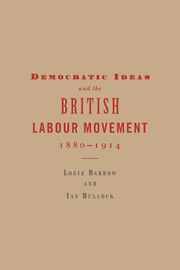Book contents
6 - The rise and fall of the Clarion federation
Published online by Cambridge University Press: 09 November 2009
Summary
It was one thing to conclude that federation by employers could and should be countered by trade union federation; quite another to say how this might be accomplished. And much harder still to turn it into reality. This chapter will look at the only major attempt ever made. This in itself would be more than reason enough for it being our most detailed; here, the anti-bureaucratic impulses which fill much of this book were to power an attempted reorganisation and, some activists hoped, revolutionising of their whole movement. Another reason is that, without proper discussion of that attempt, all existing versions of British working people's history remain more or less distortive.
The late 1890s were characterised by a cacophony of schemes for changing the interrelation of trade unions. Debates on them often developed into a war of each against all. Apart from the ups and downs within the Amalgamated Society of Railway Servants, the main surfaceevents consist of various inter-union conferences.
Some of these were extraordinary, such as the ‘Federal Labour Parliament ’ (FLP) in July 1898 which founded NIGFTLU, or the spectacular event which aborted discussion on federation at the September 1898 TUC. This allowed the TUC's Parliamentary Committee to postpone matters to a special Congress in January 1899. During the intervening months, the PC moved to undermine NIGFTLU. Some members and leading supporters of the PC resorted to bureaucratic manoeuvrings.
- Type
- Chapter
- Information
- Democratic Ideas and the British Labour Movement, 1880–1914 , pp. 109 - 136Publisher: Cambridge University PressPrint publication year: 1996

